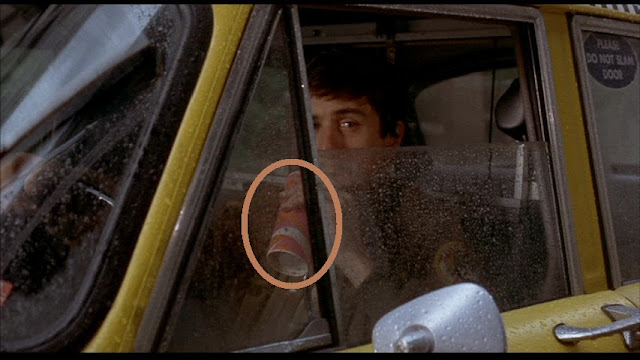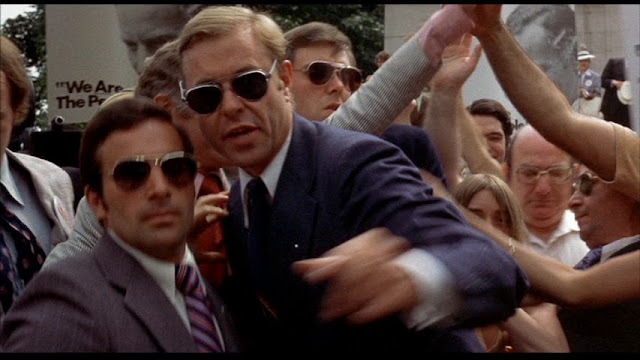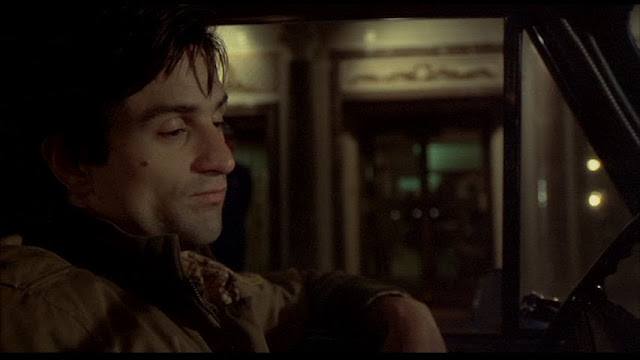
In terms of Jungian psychology (i.e., analytic psychology: the psychological theory of Swiss psychologist and psychiatrist Carl Jung), Betsy (above left) and Iris (above right), taken together, represent Travis's anima: his feminine inner personality. Betsy represents that part of his anima that serves as the mediator between his unconscious and conscious mind, and Iris represents that part of his anima that's been 'cross-contaminated' with negative aspects of his psychological shadow. The shadow is an unconscious complex defined as the repressed, suppressed or disowned qualities of the conscious self.[a]
Taxi Driver's hidden plot
The basic hidden plot in the movie is that Betsy is a 'mole' in Senator Palantine's campaign, working for some individual or group that doesn't want him to become the President. Her task is to find someone who will assassinate the Senator, such that anyone who subsequently investigates the assassination won't be able to trace it to her or the people she's working for. Betsy sometimes walks through the 'sleazy' portion of the city (that is near the campaign office) alone, hoping an 'unstable' man (a man with a highly 'unresolved' anima, such as Travis) will approach her and ask her out. When she encounters Travis, she senses that she may have found her man. Then, she subtly 'burrows' her way into Travis's unconscious, and using her consequent power as the mediator between his unconscious and conscious mind, she informs him that he is a "walking contradiction". She effectively talks him into buying the Kristofferson album containing this lyric (The Silver Tongued Devil and I). Travis listens to the album, and effectively becomes the "I" of its title (this identification happens at an unconscious level). Having become motivated to 'work with the Devil', and after being disappointed by Palantine's reaction to his suggestion to 'clean up' New York City, he attempts to 'act out' the extreme right-wing end of his contradictory nature by going to the Senator's rally to try and assassinate him. When this fails, he later goes to Iris's building and shoots three men there (including Sport), thus helping to clean up New York.
Ultimately, Scorsese's movie is, in part, an 'allegory' for Arthur Bremer's assassination attempt on Democrat presidential hopeful George Wallace in Laurel, Maryland in 1972. The manipulation of Travis (representing Bremer) by Betsy in Taxi Driver, indicates that Scorsese believes Bremer himself was psychologically manipulated by a woman he met while she was working for the Wallace campaign, and that this manipulation started Bremer on the road to his attempt on Wallace's life. This woman was working as a 'mole' in Wallace's camp for some individual or group that didn't want Wallace to be elected. By the time Wallace was campaigning, his hard-line stance against racial integration had greatly softened; the party that wanted him dead feared that this and other factors indicated that if Wallace became president, he would restore the U.S. to a true democracy.

Betsy (above left), sitting in the campaign office, sees Travis (above right) staring at her from his cab on the street outside. Note the color design of the cup he is drinking from (click image to enlarge).
As can be seen at left, Betsy has cups of the same design as Travis's, sitting in her work area. These are drinks that Betsy bought while walking through the sleazy part of the city, trying to ensnare a man - she here sees and recognizes Travis's cup, and thus knows that he visits the seedy part of town, so she realizes he might be the unstable man she's looking for.

Above left: Later, when Travis enters the campaign office and starts conversing with Betsy, she can tell from the way he talks when he 'comes on' to her, that he views her as somewhat 'pure' and thus, that he tends to see things in black and white. She knows this is characteristic of some men who are uncomfortable around women due to having unresolved feelings about them as a group (essentially, a manifestation of the unresolved anima mentioned above). Ultimately, she senses that he may have the nascent mindset of the killer she is looking for. This is why she agrees to go out with him - she believes she may eventually be able to manipulate him into assassinating Palantine. In fact, it is during this conversation that Betsy subtly begins working her way into Travis's psyche, in part by responding to him in a manner that she senses he wants her to. Above right: During the conversation, Betsy pretends to demure. She doesn't want to appear 'easy to get'.
Later in the movie, Betsy rejects Travis after he takes her to see a 'porn' film. This was by design - Betsy knew where things were headed when Travis brought her to the front of the seedy theater, even before they entered it. Her planned complete and final rejection of him was designed to leave him feeling emasculated, thus setting him up to commit a 'manly' act - the killing of someone in a position of power.


Top left: While conversing with Travis while being driven in his cab, Senator Palantine (in center in back seat) seems to empathize with Travis's stated desire to clean up New York City. Top right: However, after exiting the taxi and shaking hands with Travis, the Senator makes eye contact with a coworker as if to say, "that cab driver was a nut." Above left: Travis, who noticed this interaction, is disappointed that the Senator did not seriously consider his advice. Above right: A long-barreled gun Travis later purchases, here serves as a phallic symbol. According to plan, Travis thinks he has found a way to alleviate his feeling of emasculation.
The Senator was 'set up' by being directed to enter Travis's cab instead of taking his limousine (as per normal procedure). The man sitting to the Senator's left in the top left screencap above, is a corrupt Secret Service agent. During the ride, he says that the party should have waited for the limousine instead of taking a cab - the agent says this in anticipation of the chance that the other passenger in the cab (Palantine's coworker) would later (after the planned assassination) be questioned about why a cab was taken that night; the corrupt man would, by making this statement, avoid any suspicion being directed at himself. This man knew what Travis looked like (and thus knew which cab to put the Senator in) via someone (Betsy, or another mole) having described Travis's appearance to him, or even more likely, from viewing a photograph of Travis. It's probably the case that either someone took a photo of Travis unbeknownst to him, or else his taxi driver license, containing a photo of him, was obtained by the evil parties who want the senator dead, from the taxi company Travis works for. All of this is part of the Bremer/Wallace 'allegory' - which is not to be taken so literally as to indicate that, for example, the real-life mole's name was Betsy, or some such thing. Generally speaking, what we are supposed to realize is that some violent acts that are blamed (by police, the media, etc.) on 'lone-gunmen nuts', are ultimately committed by governmental or other powerful entities, without these acts being traceable to these entities. The individual gunmen themselves do not know that they are being manipulated, and instead believe that they are acting alone. It is crucial to understand what we have done here: We have connected supposed 'lone gunmam'/'lone nut' assassination (and other violent act) scenarios to so-called 'conspiracy theories' claiming that powerful parties are behind some of these acts. And, we have described in relative detail how it is that a certain kind of man, i.e., one with a highly unresolved anima (Travis), can be manipulated by evil parties.


Top left: At the first Palantine rally that Travis goes to, the tall man who questions him is a (non-corrupt) Secret Service agent, here taking down Travis's name and address under the pretext that he will have information sent to Travis about how to join the Service. (Travis gives him false information.) Top right: After the man is done talking to Travis, who has started to walk away, he motions to his fellow agent (who, unbeknownst to him, is corrupt; this is the same agent who was riding in Travis's taxi), to go after Travis and snap some pictures of him. Above left: The (corrupt) man, holding his camera, gets ready to pursue Travis. Above right: Initially, Travis, as he walks away, is facing away from the man with the camera.

Above left: While still walking away, Travis turns around a couple of times, exposing his face. His reason for doing so is that he wants his photo to be taken - he figures he will be identified as a hero after he assassinates the Senator, and he wants the public, via stories about him in the media, to know what he looked like. Travis knows the man has a camera because he saw him with it while Palantine was giving his speech. The man, since he has a camera, probably appears to the other people at the rally to be a member of the press. However, Travis recognizes him from the earlier cab ride. Above right: The agent with the camera, although he is positioned to snap a photo of Travis, intentionally delays long enough so that Travis gets lost in the crowd. The man exclaims, "Damn it!" while subsequently lowering his camera, so as to appear to his fellow agent (in case he's within hearing range), to not have been able to get any photos.

Above left: Later, at the second Palantine rally Travis attends, we see him about to draw his gun in preparation for shooting the Senator. Above right: The (non-corrupt) agent spots Travis and motions for the (corrupt) agent to go after him.
Above: The film's 'give-away' that the man sent to chase Travis is not acting in earnest, and is thus corrupt, is his body position upon colliding with the man in the orange shirt, while appearing to vigorously pursue Travis: A person who coincidentally collided with another individual while running quickly in pursuit of someone, would collide with their body in a mainly upright position, since this is the body's basic position while running. Instead, however, the agent bends forward at the waist and bends his knees just long enough prior to the collision, to avoid going down too hard on the pavement, indicating that he is really feigning an accidental collision. The point is that the agent didn't really want to 'catch' Travis, and he made things appear such that the collision prevented him from doing so.
The film's ending portion is a dream


Above left: After Travis has killed the men in Iris's rooming house, he attempts to commit suicide, but he's out of bullets. Above right: The fact that Travis knows he's about to die, is indicated by his feigned shooting of himself in front of the police while sitting on the couch.

While Travis is sitting on the couch bleeding from his neck, he fades out of consciousness and begins to experience a dream. Everything we see in the movie after this point in time, consists of the contents of this dream. The view of the dying Travis from above, suggests that he is here in a metaphorical Hell.


Above left and right: Travis's being depicted as a hero by the media (above left), giving a cab ride to Betsy (above right), etc., constitute the dream sequence he experiences just before he dies, from excessive bleeding due to the injuries he sustained during the shoot-out in Iris's building.
a. Wikipedia, 'Analytical psychology'. Web, n.d. URL = https://en.wikipedia.org/wiki/Analytical_psychology.










